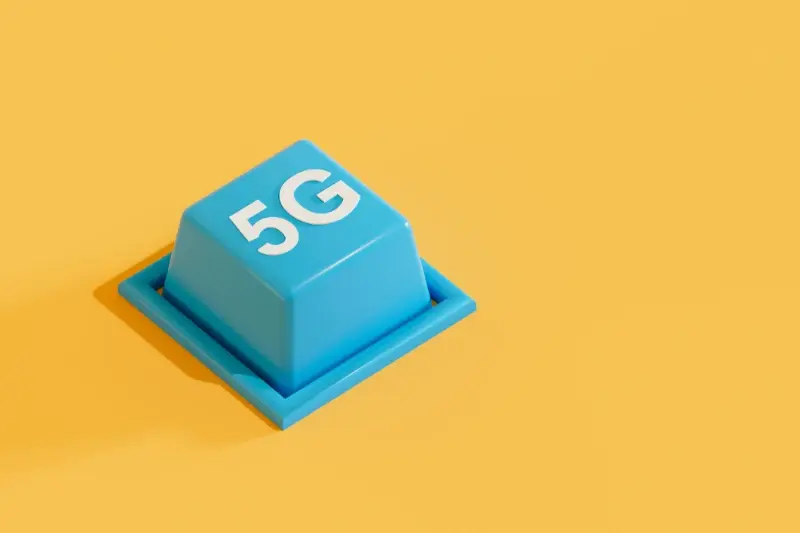From Concept to Launch: Building Your First 5G Mobile App
Have you ever wondered what happens when the fastest mobile network technology meets your brilliant app idea? I've been working in mobile app development for years now, and I can tell you that 5G isn't just another upgrade—it's completely changing how we think about what's possible. This development guide will walk you through everything you need to know about building your first 5G mobile app, from that initial spark of an idea right through to seeing it live in the app stores.
When 5G first started rolling out, I'll admit I was a bit sceptical about whether it would make that much difference to everyday users. But after working on several 5G-enabled projects, I've seen firsthand how this technology implementation opens doors that were previously locked shut. We're talking about apps that can stream ultra-high-definition video without buffering, augmented reality experiences that feel genuinely real, and real-time collaboration tools that actually work in real-time.
The shift from 4G to 5G is like moving from a country road to a motorway—suddenly, the journey possibilities expand dramatically
Building a 5G mobile app isn't just about making your existing app faster (though that's nice too). It's about reimagining what your app can do when speed, latency, and bandwidth are no longer limiting factors. Throughout this guide, we'll explore the practical steps you need to take, the tools you'll need to master, and the common pitfalls to avoid. Whether you're a seasoned developer looking to leverage new capabilities or someone taking their first steps into app development, this journey from concept to launch will equip you with the knowledge to build something truly special.
Understanding 5G Technology and Its Impact on Mobile App Development
Let me start by saying this—5G isn't just faster 4G. That's probably the biggest misconception I hear when people talk about this technology. Sure, speed is part of it, but there's so much more going on under the hood that changes everything about how we build mobile apps.
5G brings three major improvements that matter for app developers. First, we get speeds up to 100 times faster than 4G—we're talking about downloading entire films in seconds rather than minutes. Second, latency drops to almost nothing; the delay between tapping your screen and something happening becomes practically invisible. Third, 5G can handle way more devices connected at once without everything grinding to a halt.
What This Means for Your App Development
These improvements open doors that were previously locked shut. Real-time multiplayer games become smoother. Video streaming can jump to 4K without buffering. Augmented reality apps can respond instantly to your movements. Cloud-based processing becomes viable for tasks that used to require powerful hardware.
But here's the thing—just because you can doesn't mean you should. 5G coverage isn't everywhere yet, and not everyone has 5G-capable devices. Your app still needs to work brilliantly on older networks.
Key Areas Where 5G Makes a Difference
- Real-time collaboration tools and video conferencing
- Augmented and virtual reality applications
- Cloud gaming and streaming services
- IoT device control and monitoring
- Live video broadcasting and content creation
- Machine learning apps using cloud processing
The smart approach is building apps that take advantage of 5G when it's available but gracefully scale back on slower networks. Think of it as future-proofing your app while keeping it accessible to everyone.
Planning Your 5G Mobile App Strategy
Right, let's get down to the nitty-gritty of planning your 5G mobile app strategy. This isn't about throwing together a quick development guide and hoping for the best—you need a proper plan that makes sense for your specific situation.
The first thing you need to figure out is whether your app actually needs 5G capabilities. I know that sounds obvious, but you'd be surprised how many people jump straight into 5G development without asking this basic question. If your app is a simple to-do list or basic calculator, 5G probably isn't going to add much value. But if you're building something that involves real-time gaming, augmented reality, or heavy data processing, then 5G could be a real game-winner.
Identifying Your 5G Use Cases
Think about what 5G actually brings to the table: faster speeds, lower latency, and better connectivity in crowded areas. Your mobile app needs to take advantage of at least one of these benefits to justify the extra complexity in your technology implementation.
- Real-time multiplayer gaming with instant responses
- High-quality video streaming without buffering
- AR/VR experiences that need quick data processing
- IoT applications connecting multiple devices
- Live collaboration tools with instant updates
Setting Realistic Expectations
Here's the thing—5G coverage isn't everywhere yet, and your users might not all have 5G-compatible devices. Your app needs to work brilliantly on 4G networks too, with 5G features as a bonus rather than a requirement. Plan for graceful degradation; that means your app should automatically adjust its features based on the network connection available.
Start by mapping out your core app features that work on any network, then identify which enhanced features can take advantage of 5G capabilities. This approach means you won't exclude users who don't have 5G access yet.
Essential Technologies and Tools for 5G App Development
Right, let's talk about the actual tech stack you'll need to build your 5G app. After years of working with different technologies, I've learned that choosing the right tools can make or break your development process—and your budget.
The foundation of any solid 5G app starts with your development framework. Native development using Swift for iOS and Kotlin for Android gives you the deepest access to 5G capabilities, but cross-platform solutions like Flutter and React Native are catching up fast. Flutter, in particular, has impressive performance when it comes to handling high-speed data streams that 5G delivers.
Core Technologies You'll Need
For backend infrastructure, you're going to want cloud services that can scale with 5G's speed. AWS, Google Cloud, and Microsoft Azure all offer edge computing solutions that bring your servers closer to users. This matters more with 5G because users expect near-instant responses.
Here's what should be on your technology checklist:
- WebRTC for real-time communication features
- GraphQL for efficient data querying
- Docker containers for scalable deployment
- Redis for high-speed caching
- WebGL or Metal for intensive graphics processing
Development and Testing Tools
You'll need specialised testing tools since 5G networks aren't everywhere yet. Network simulation tools like Charles Proxy or Proxyman help you test high-bandwidth scenarios. Don't forget about analytics tools like Firebase Analytics or Mixpanel—they're crucial for understanding how users interact with your app's new 5G features.
The key is starting simple with proven technologies, then adding complexity as your app grows. You don't need every shiny new tool from day one.
Designing User Experiences for 5G Applications
When you're designing a mobile app for 5G networks, everything changes—and I mean everything. The old rules about keeping things simple because of slow connections? Throw them out the window. With 5G's lightning-fast speeds and minimal delay, you can now create experiences that were impossible just a few years ago.
The first thing to understand is that users will expect your app to respond instantly. No more excuses about loading times or buffering. Your 5G mobile app needs to feel immediate and smooth. This means rethinking how you handle data, images, and video content. You can now load high-quality visuals without worrying about eating up someone's data allowance or making them wait.
Real-Time Features Become Standard
5G opens up incredible possibilities for real-time interactions. Video calls become crystal clear, augmented reality features work seamlessly, and live streaming becomes as smooth as watching regular video. But here's the thing—just because you can doesn't mean you should cram every possible feature into your app.
The best 5G applications don't just use the technology for the sake of it; they solve real problems that couldn't be solved before
Planning for Progressive Enhancement
Not everyone will have access to 5G networks immediately, so your development guide should include fallback options. Design your app to work brilliantly on 5G but gracefully downgrade for 4G users. This technology implementation approach means thinking about which features are core to your app's function and which are 5G-enhanced extras. Your users will thank you for considering their actual network conditions rather than assuming they're always connected to the fastest possible network.
Building and Coding Your 5G Mobile App
Right, here's where the real work begins—actually building your 5G app. I'll be honest, this is where many developers get a bit overwhelmed because 5G isn't just about faster internet speeds. The technology opens up completely new possibilities that traditional mobile development approaches simply can't handle.
Your development approach needs to be different from standard mobile apps. With 5G's ultra-low latency and massive bandwidth, you're dealing with real-time data processing, edge computing integration, and network slicing capabilities. These aren't just buzzwords—they're fundamental shifts in how your app architecture should work.
Key Development Considerations
When coding for 5G, you'll need to think about network awareness first. Your app should dynamically detect when 5G is available and adjust its behaviour accordingly. This means implementing adaptive streaming protocols, optimising for edge server connections, and building in failsafe mechanisms for when users drop back to 4G networks.
- Implement network detection APIs to identify 5G connectivity
- Use adaptive bitrate streaming for video and media content
- Build modular code that scales features based on network capability
- Integrate WebRTC for real-time communication features
- Optimise data synchronisation between edge servers and cloud storage
Performance Optimisation
The biggest mistake I see developers make is assuming 5G means they can be lazy with optimisation. Wrong! 5G users expect lightning-fast responses, which means your code needs to be cleaner and more efficient than ever. Focus on reducing computational overhead, minimising memory usage, and implementing smart caching strategies that take advantage of 5G's capabilities rather than working against them.
Testing and Optimising for 5G Networks
Testing your mobile app on 5G networks isn't quite the same as testing on older networks—and trust me, I've learnt this the hard way! The speeds are much faster, but that doesn't mean everything automatically works better. You need to test how your app handles these super-fast connections and what happens when users switch between 5G and 4G areas.
Start by testing your app in different network conditions. 5G isn't available everywhere yet, so your app needs to work well when it drops back to 4G or even 3G. This switching between networks can cause problems if you haven't planned for it. Your mobile app development guide should include testing on real 5G devices in real locations—not just in the lab.
Key Testing Areas for 5G Apps
- Battery usage when connected to 5G networks
- Data transfer speeds and app performance
- Network switching between 5G and older networks
- Edge computing features and latency
- Large file downloads and streaming quality
Test your app during peak and off-peak hours on 5G networks. Network performance can vary dramatically based on how many people are using the same cell tower.
Optimising for 5G means taking advantage of the faster speeds without draining the battery. Your technology implementation should include smart caching—downloading content when the connection is strong and storing it for later use. Monitor how much data your app uses too; just because 5G is fast doesn't mean users want unlimited data consumption.
Performance Monitoring
Set up analytics to track real-world performance once your app launches. Look at connection speeds, error rates, and user behaviour patterns across different network types. This data helps you make improvements and spot problems before users start complaining about them.
Preparing for App Store Launch
You've built your 5G app, tested it thoroughly, and optimised it for the latest networks—now comes the part that makes many developers nervous. Getting your app ready for the app stores isn't just about uploading files and hoping for the best. There's a proper process to follow, and missing steps here can delay your launch by weeks.
The app store submission process has become much more rigorous over the years. Both Apple's App Store and Google Play Store have strict guidelines about what they'll accept, and 5G apps often face additional scrutiny because they use advanced network features. Your app needs to work perfectly on devices that don't have 5G access too—something the review teams will definitely check.
App Store Requirements Checklist
- App icons in all required sizes (from 16x16 to 1024x1024 pixels)
- Screenshots for different device sizes and orientations
- App description highlighting 5G features without making them mandatory
- Privacy policy explaining what data your app collects and how it uses 5G capabilities
- Age rating appropriate for your app's content
- Metadata including keywords, category, and pricing information
- Beta testing results from TestFlight or Google Play Console
Final Technical Checks
Before you hit submit, run through your app one more time on different devices. Check that it gracefully handles switching between 4G and 5G networks—this happens more often than you'd think, especially in areas with patchy 5G coverage. Your app should never crash when the network changes, and users should barely notice the transition.
The review process typically takes anywhere from 24 hours to several days. Use this time wisely; prepare your marketing materials, set up analytics tracking, and get ready to respond quickly if the review team has questions about your 5G implementation. Remember that launching an app is not the final step—the real work begins once your users start downloading and using your creation.
Conclusion
Building your first 5G mobile app isn't just about following a development guide—it's about understanding that you're creating something for the future of mobile technology. The speed and power that 5G networks offer mean your app can do things that simply weren't possible before. Real-time collaboration, instant video processing, and immersive experiences are now within reach for any developer willing to learn.
What I find most exciting about 5G mobile app development is how it changes the rules. You're no longer constrained by slow loading times or worried about heavy data transfers. Your users expect apps that work instantly, and 5G gives you the tools to deliver exactly that. The technology implementation might seem overwhelming at first, but once you break it down into manageable steps—planning, designing, coding, testing, and launching—it becomes much more approachable.
The mobile app market is competitive, but that's what makes building something truly useful so rewarding. Your 5G app has the potential to solve real problems in ways that older technology couldn't handle. Whether you're streaming high-quality content, processing data in real-time, or creating interactive experiences, you now have the network infrastructure to support ambitious ideas.
Don't expect perfection on your first attempt. Every experienced developer has built apps that didn't quite work as planned. The key is learning from each project and applying those lessons to the next one. Your first 5G mobile app is just the beginning of what could become an exciting journey in mobile development.
Share this
Subscribe To Our Blog
You May Also Like
These Related Stories

The Ultimate Guide to 5G App Development in 2025

Why Most 5G Apps Fail (and How to Build One That Doesn't)





